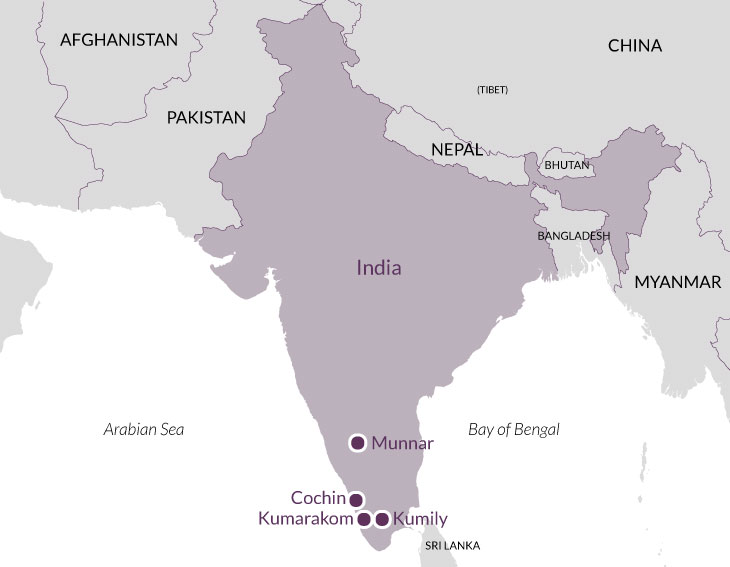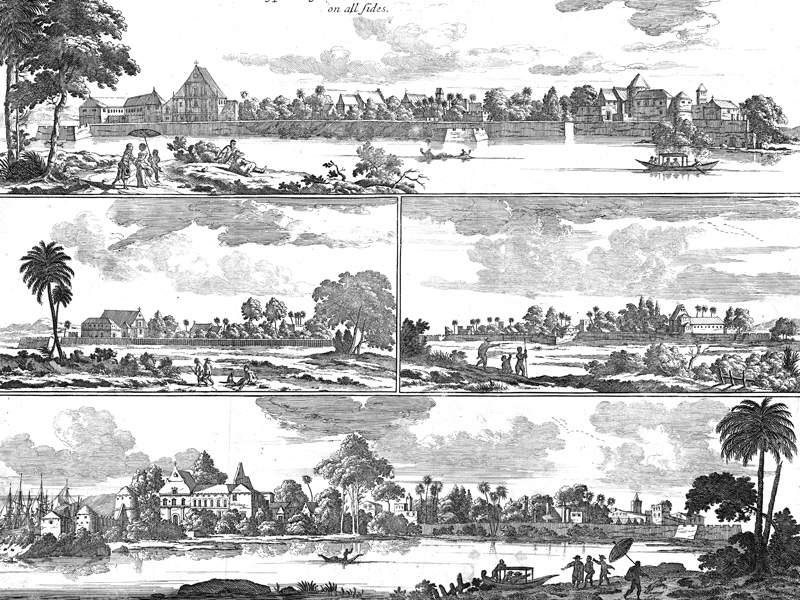Overview
Kerala has supplied the world with spices since antiquity. Roman ships sailed to the Malabar Coast laden with sacks of gold to trade for their favourite spice, black pepper. Modern Kerala is still a major producer of black pepper and this tour follows in the footsteps of Chinese, Persian, Jewish, Arab and European merchants who have been coming here ever since in search of spices.
The warm but cloudy climate of the Western Ghats provides the perfect conditions for cultivating pepper vines that wither in strong sunlight. On the distinctively-shaped knolls, pepper plants straggle among the fronds of cardamom trees while large tracts of the hills are covered by neat rows of bright green tea bushes.
When the Portuguese discovered the sea route to India in the fifteenth century they stumbled into the most intense commercial zone in the world. Kerala’s spice markets attracted merchants trading African slaves, gold and ivory, precious stones, dyes and rugs from the Persian Gulf, Chinese silks and porcelain, nutmeg and cloves from the Indonesian archipelago. The Portuguese quickly established a trading base at Fort Cochin and within thirty years of their arrival on the scene dominated Indian Ocean trade until they were superseded by the Dutch in the seventeenth century; their churches are a testimony to their determination to demonstrate their religious hegemony as well as their military might.
The Paradesi synagogue in the Jewish quarter is almost the last trace of Kerala’s Jewish community (most of Cochin Jews have now emigrated to Israel). However, the community have left behind a cookery tradition influenced by the Middle Eastern and Spanish origins of the Indian Jews. Kerala’s Syrian Christian community is also thought to have been founded as long ago as the first century AD. St Thomas the Apostle is said to have made a number of converts to Christianity while on a proselytising mission to South India. This Nesrani community is famous for its appam, soft rice breads, fluffy in the centre and crispy on the edge, perfect for dipping in the stews which characterise their cuisine. A fragrant biryani is the best-known contribution of the Arab spice traders to the Keralan culinary repertoire. The Portuguese introduced creamy custards and pastries as well as an array of foods which they had only just discovered themselves in the Americas: the chilli pepper eventually came to dominate Indian cookery, ousting black pepper from its position as the hottest spice. The Portuguese also introduced cassava (tapioca), now widely eaten in Kerala.
Tea cultivation was introduced to India by the British and one of the Raj’s most enduring legacies was to persuade Indians to drink tea after a concerted campaign in the late nineteenth century.
The hallmark of Keralan, and Indian, cuisine is that it has absorbed influences from each wave of visitors, from early Christians and medieval Muslim Sultans to the English bureaucrats of the Raj. Food, then, is one of the best vehicles to explore India’s colourful history and Kerala’s cuisine is no exception. Cooking demonstrations and privately hosted lunches allow participants to revel in Kerala’s rich and delicious culinary history, while gentle walks in tea and spice plantations provide some insight in the production of these once luxurious goods.
Day 1
Cochin. The tour begins in Cochin with lunch in the hotel restaurant at c. 12.30pm (flights from London are not included. Your room is available from 2.00pm on 15th February–see practicalities). Later in the afternoon, visit the Mattancherry Palace. First built by the Portuguese in 1557, it was rebuilt by the Dutch in 1663. The murals in the king’s bedroom which depict mythical scenes from the Raas Leela and the Ramayana are a masterpiece of Keralan paintings. Dinner in the hotel restaurant explores the rich culinary heritage of this trading centre. Overnight Cochin.
Day 2
Cochin. A morning walk around Fort Cochin includes the Chinese fishing nets, which have been in use since the 14th century and St Francis Church (c. 1510), one of the earliest Catholic churches in India and the temporary resting place of Vasco da Gama. A cooking demonstration focusing on the Mopilah (Muslim) culinary tradition of northern Kerala precedes a private lunch. Muslim traders may have settled on the Malabar Coast as early as in the 7th century and have since developed a cuisine with distinctive flavours. Free afternoon. Overnight Cochin.
Day 3
Fort Cochin. Jewish merchants and Christian settlers arrived in Kerala with St Thomas the Apostle in 52 AD. The Paradesi Synagogue, built in 1568 by European Jews, is tucked away in the heart of the Jewish Quarter. Its airy interior is enhanced by hand painted Chinese floor tiles and European glass chandeliers. A cooking demonstration is followed by a Christian lunch in a private home. Opened in 2009, the Folklore Museum houses a private collection of Keralan artefacts. Overnight Cochin.
Day 4
Cochin, Munnar. In the morning, drive through the coconut palms and spice plantations of the low- and midlands to Munnar, the centre of Kerala’s tea industry. Located at an altitude of 1,600 metres, this hill station was discovered by Scottish planters in the 19th century and was once the British Summer capital of south India. Tea tasting session in the afternoon. First of two nights in Munnar.
Day 5
Munnar. Drive around the rolling hills to one of the 30 tea estates in the area. After a walk around the plantation witnessing pickers at work, visit the processing factory. A Tamil-style lunch reflects the tea workers’ origin from the neighbouring state. Overnight Munnar.
Day 6
Munnar to Kumily. Leaving the tea growing region of the high altitudes, drive through thick forests of teak and rosewood to reach Thekkady. Afternoon walk around a spice plantation to explore the growing process and the complex network of correlations between species. In the evening, dinner focuses on locally farmed produce. Overnight Kumily.
Day 7
Kumily to Kumarakom. Drive to a planter’s home for a privately hosted British-influenced lunch. Afternoon drive to the backwaters, a network of lakes, lagoons and canals with its unique ecosystem. First of three nights in Kumarakom.
Day 8
Kumarakom. Morning walk around Alappuzha (Allepey), the first planned city in Kerala, dating from 1776. The dilapidated mansions of the Gujarati spice merchants are easily recognisable with their intricately carved wooden gates. After the final cooking demonstration, lunch is sadhya, the Keralan banquet consisting of a variety of vegetarian dishes and traditionally served on a banana leaf. Return to the hotel by boat. Overnight Kumarakom.
Day 9
Kumarakom. In Kottayam, the 450-year old Cheria Palli – ‘Small’ St Mary’s Church – displays unusual symbols on its façade. The original murals inside were painted using natural pigments. Nearby, the Valia Palli – ‘Big’ St Mary’s Church – houses 2 Nestorian crosses, one of which may be the oldest Christian artefact in India. The hosted lunch highlights the distinctive culture of the region and is followed by a walk around the farm. The rest of the afternoon is free. Overnight Kumarakom.
Day 10
Kumarakom. Transfers to Cochin Airport are arranged for your onward journey.
Price, per person
Two sharing: £5,030. Single occupancy: £5,940.
Included
Arrival and departure airport car transfers; travel by private air-conditioned coach and by jeep; accommodation as described below; breakfasts, 8 lunches and 7 dinners with beer, water, and coffee at lunch and wine at dinner (where available - not all restaurants serve alcohol); all admissions; all food tastings; all tips; the services of the lecturer, tour manager and local guides.
Flights
Flights from London to Cochin are not included in the price of the tour. We will send the recommended flight options when they are available to book, towards the middle of March 2019, and ask that you make your own flight reservation. The cost of a World Traveller (economy) seat with British Airways at the time of going to press is c. £650.
Visas
Required for most foreign nationals, and not included in the tour price. We advise you of the process.
Accommodation
Brunton Boatyard Hotel, Cochin: sea-front property, ideally located within the heritage area of Fort Cochin. Windermere Estate, Munnar: family-run property offering stunning views of the surrounding plantations. Spice Village Hotel Kumily: eco-friendly hotel set in the lush landscape of the Western Ghats. Hotel Coconut Lagoon, Kumarakom: comfortable bungalows in natural lake-side settings.
How strenuous?
Unless you enjoy entirely unimpaired mobility, cope with everyday walking and stair-climbing without difficulty, this tour is not for you. Sure-footedness is essential for boarding and disembarking the boats; jetties may be slippery. Walks in the tea and spice plantations are over uneven ground and there are some uphill climbs. There are two coach journeys of 4 hours or more where facilities may be limited. Average distance by coach per day: 35 miles.
Are you fit enough to join the tour?
Tour Manager
Hubert Giraud
Group size
Between 10 and 22 participants.
Travel advice
Before booking, please refer to the FCDO website to ensure you are happy with the travel advice for the destination(s) you are visiting.

